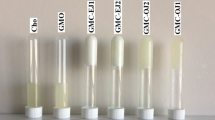Abstract
Supramolecular gels are soft materials formed mainly by low molecular weight units held together by intermolecular interactions. Stabilizing these kinds of materials is quite a challenge due to the influence of multiple factors interfering with the integrity of the supramolecular structure. In our previous studies, we have shown that the aminocarbohydrate meglumine (MEG) interacts with organic acids by ion-pairing leading to the formation of MEG–carboxylate adducts. These adducts undergo supramolecular polymerization by heat treatment, but the macromolecular assembly was stable for a short period due to hydrogen bond (H-bond) breakup. Herein, we attempt to study the influence of hydrophobic building blocks on the formation of these compounds aiming to stabilize H-bonds to produce polymerizable supra-amphiphiles in water. Oleic acid and stearic acid are two analogous fatty acids differing only in the presence of unsaturation that were used in our studies. Results demonstrated that the presence of unsaturation hinders gelation in water by interfering with the self-assembly behavior of supra-amphiphiles. Thus, unsaturated supra-amphiphiles behave like traditional surfactants and gelify water at high concentrations (above 30% w/w). On the other hand, supramolecular gels with a polymer-like behavior could be produced with a saturated supra-amphiphile in water (above 4% w/w). The material was characterized by a lamellar arrangement that facilitates the alignment of H-bonds necessary to stabilize the self-assembled structure. These results have pivotal importance on the design of polymerizable supra-amphiphiles and demonstrate that the double bond of hydrophobic building blocks is an important design factor to be considered by scientists studying similar materials.











Similar content being viewed by others
References
Wojtecki RJ, Meador MA, Rowan SJ. Using the dynamic bond to access macroscopically responsive structurally dynamic polymers. Nat Mater. 2011;10(1):14–27.
Webber MJ, Appel EA, Meijer EW, Langer R. Supramolecular biomaterials. Nat Mater. 2015;15(1):13–26.
Huang F, Scherman OA. Supramolecular polymers. Chem Soc Rev. 2012;41(18):5879–80.
Sangeetha NM, Maitra U. Supramolecular polymers. Chem Soc Rev. 2005;34(10):821–36.
Kang Y, Liu K, Zhang X. Supra-amphiphiles: a new bridge between colloidal science and supramolecular chemistry. Langmuir. 2014;30(21):5989–6001.
Zhang S, Bellinger AM, Glettig DL, Barman R, Lee YL, Zhu J, Cleveland C, Montgomery VA, Gu L, Nash LD, Maitland DJ, Langer R, Traverso G. A pH-responsive supramolecular polymer gel as an enteric elastomer for use in gastric devices. Nat Mater. 2015;14(10):1065–71.
Dawn A, Shiraki T, Ichikawa H, Takada A, Takahashi Y, Tsuchiya Y, Lien LTN, Shinkai S. Stereochemistry-dependent, mechanoresponsive supramolecular host assemblies for fullerenes: a guest-induced enhancement of thixotropy. J Am Chem Soc. 2012;134(4):2161–71.
Jones D, Steed JW. Gels with sense: supramolecular materials that respond to heat, light and sound. Chem Soc Rev. 2016;45(23):6546–96.
Mollet BB, Comellas-Aragons M, Spiering AJH, Sntjens SHM, Meijer EW, Dankers PYW. A modular approach to easily processable supramolecular bilayered scaffolds with tailorable properties. J Mater Chem B. 2014;2(17):2483–93.
Cassimiro DL, Ribeiro CA, Capela JMV, Crespi MS, Capela MV. Kinetic parameters for thermal decomposition of supramolecular polymers derived from flunixin-meglumine adducts. J Therm Anal Calorim. 2011;105(2):405–10.
Ferreira LMB, Kurokawa SSS, Alonso JD, Cassimiro DL, Souza ALR, Fonseca M, Sarmento VHV, Regasini LO, Ribeiro CA. Structural and thermal behavior of meglumine-based supra-amphiphiles in bulk and assembled in water. Langmuir. 2016;32(45):11878–87.
Cassimiro DL, Kobelnik M, Ribeiro CA, Crespi MS, Boralle N. Structural aspects, thermal behavior, and stability of a self-assembled supramolecular polymer derived from flunixin–meglumine supramolecular adducts. Thermochim Acta. 2012;529:59–67.
Obert E, Bellot M, Bouteiller L, Andrioletti F, Lehen-Ferrenbach C, Boue F. Both water- and organo-soluble supramolecular polymer stabilized by hydrogen-bonding and hydrophobic interactions. J Am Chem Soc. 2007;129(50):15601–5.
Chandler D. Interfaces and the driving force of hydrophobic assembly. Nature. 2005;437(7059):640–7.
Teixeira Neto E, Malta MM, Santos RG. Surface tension measurement by drop counting method: method description and experiments with etoxilated non-ionic surfactants. Quim Nova. 2009;32(1):223–7.
Durairaj B, Blum FD. Micelle formation and terminal double bonds in sodium carboxylates. J Colloid Interface Sci. 1985;106(2):561–4.
Edwards W, Smith DK. Enantioselective component selection in multicomponent supramolecular gels. J Am Chem Soc. 2014;136(3):1116–24.
Edwards W, Smith DK. Dynamic evolving two-component supramolecular gels hierarchical control over component selection in complex mixtures. J Am Chem Soc. 2013;135(15):5911–20.
Pal A, Basit H, Sen S, Aswal VK, Bhattacharya S. Structure and properties of two component hydrogels comprising lithocholic acid and organic amines. J Mater Chem. 2009;19(25):4325–34.
Basit H, Pal A, Sen S, Bhattacharya S. Two-component hydrogels comprising fatty acids and amines: structure, properties, and application as a template for the synthesis of metal nanoparticles. Chem Eur J. 2008;14(21):6534–45.
Acknowledgements
This work was financially supported by the Grant #2013/08411-0, São Paulo Research Foundation (FAPESP). We acknowledge the LNLS (Campinas, SP, Brazil) staff for SAXS facilities.
Author information
Authors and Affiliations
Corresponding author
Electronic supplementary material
Below is the link to the electronic supplementary material.
Rights and permissions
About this article
Cite this article
Cassimiro, D.L., Ferreira, L.M.B., de Souza, A.L.R. et al. On the influence of fatty acid chain unsaturation on supramolecular gelation of aminocarbohydrate-based supra-amphiphiles. J Therm Anal Calorim 134, 1599–1609 (2018). https://doi.org/10.1007/s10973-018-7333-5
Received:
Accepted:
Published:
Issue Date:
DOI: https://doi.org/10.1007/s10973-018-7333-5




